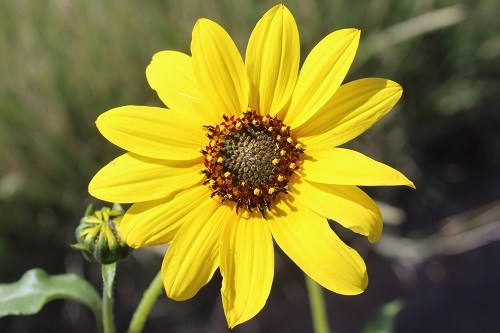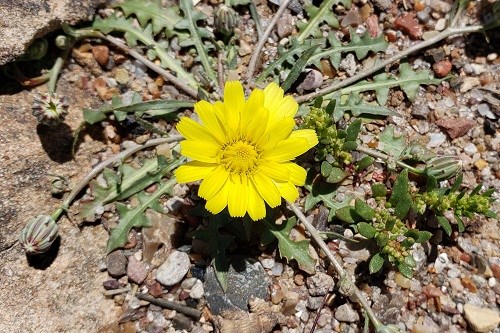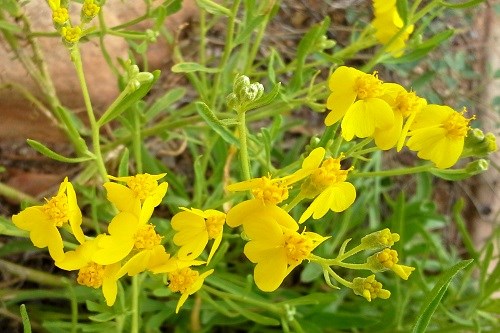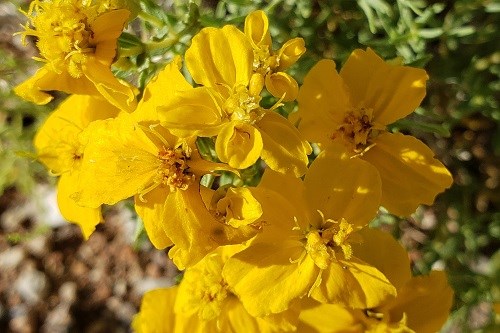



Sunflower, Daisy, Aster, and Allies Family Asteraceae Blooms July through October
False Hairy Golden Aster (Heterotheca villosa) is a tough perennial with a spicy scent. Drought doesn’t affect it, but it is also opportunistic, often growing alongside roads that offer night warmth and moisture. Sunflower, Daisy, Aster, and Allies Family Asteraceae. Blooms May-October.
Fineleaf Woollywhite (Hymenopappus filifolius), a member of Asteraceae (Sunflower Family), have yellow button blooms made up only of disk flowers. The leaves are pale and highly divided, forming a mound near the bottom of many long stems. Blooms May-August.

Loomis' Thimblehead (Hymenothrix loomisii) is tall with lots of fluffy highly dissected leaves on the lower half. The blossoms consist of white, cream, to yellow disc flowers with large corolla lobes, borne in open panicles at the top of the plant. These annuals to perennials can form large colonies along the park road. Sunflower, Daisy, Aster, and Allies Family Asteraceae. Blooms August-October.
Rusby's Goldenbush (Isocoma rusbyi) forms rounded shrubs with a woody base when mature and tan upright stems. The narrow leaves are hairless but can be resinous. The terminal clusters of golden blooms are mostly discoid. Sunflower, Daisy, Aster, and Allies Family Asteraceae. Blooms July-September.

New Mexico Groundsel (Packera neomexicana) was once park of the Senecio genus but moved due to recent research. This sturdy plant has serrated paddle-shaped leaves at the base with umbels of sunny yellow daisies on top. There are four varieties of this species in Arizona. Sunflower, Daisy, Aster, and Allies Family Asteraceae. Blooms May and June.

Woolly Paperflower (Psilostrophe tagetina) is a shrub-like perennial. The green stems with small leaves are topped by bright gold blossoms. Each consist of a few lobed ray flowers and a few disk flowers. Sunflower, Daisy, Aster, and Allies Family Asteraceae. Blooms May-September.
Upright Prairie Coneflower (Ratibida columnifera) is a perennial. The ray flowers tend to droop down while the disc flowers form a large, upright cone. Sunflower, Daisy, Aster, and Allies Family Asteraceae. Blooms June-September.

Broom-like Ragwort (Senecio spartioides) has an airy habit with upright stems and green, narrow leaves, lower ones often dying as the flowers appear. The yellow daisy flowers are in loose, flat-topped clusters and turn into fluffy puffs. Sunflower, Daisy, Aster, and Allies Family Asteraceae. Blooms June-October.
Stemless Four-nerved Daisy (Tetraneuris acaulis) is a cheerful yellow daisy on a leafless stem a little longer than the basal rosette of lanceolate leaves. The phyllaries under/behind the petals can be quite fuzzy with hints of red. The notched petals and the over-lapping rows (two or three) of hairy and broadly lanceolate phyllaries are very attractive characteristics. The leaves are a bit succulent with glands. Sunflower, Daisy, Aster, and Allies Family Asteraceae. Blooms May-July.
Ives' Four-Nerve Daisy (Tetraneuris ivesiana) is another perky sue with shorter basal leaves and stems. In rocky areas the basal rosette may be very small. Some flowers may have splashes of white. The notched petals, the even rows of green, finger-like phyllaries, and the densely hairy stems are diagnostic characteristics. The leaves are narrow and pointed. Sunflower, Daisy, Aster, and Allies Family Asteraceae. Blooms May-September.
Spineless Horsebrush (Tetradymia canescens) is a silvery shrub. The minute leaves look similar to the flower buds. The flowers—four disk florets each—are small but many giving a golden glaze to the exterior of the shrub before becoming tan fluff. The seeds are dispersed by wind. Sunflower, Daisy, Aster, and Allies Family Asteraceae. Blooms June-August.

Yellow Salsify (Tragopogon dubius) is an invasive, non-native originally brought here for its edible root. The large yellow flowers turn into huge fluffy puffballs. Sunflower, Daisy, Aster, and Allies Family Asteraceae. Blooms May-September.

Saw-toothed Goldenweed (Xanthisma grindelioides) is a small cluster of saw-toothed leaves on upright stems. The end of the stem has the rayless bloom of yellow disk flowers. Phyllaries have sticky glands that often trap debris. Sunflower, Daisy, Aster, and Allies Family Asteraceae. Blooms May-August.

Fringed Puccoon (Lithospermum incisum) is a member of the Boraginaceae (Forget-Me-Not Family). The lemony yellow fringed trumpet flowers are bright against the lanceolate darker green leaves. It is a long bloomer until the heat of summer builds.Blooms March-July

The multiple native and one non-native Descurainia species in the Four Corners area are not easy to identify. Each species has variability and possibly interbreed. Species may be defined by the divisions in their leaves, shape and size of their fruit (siliques), and amount and types of hairs. That all being said, here is a Tansy Mustard (Descurainia sp.). Mustard Family Brassicaceae Blooms February-September 
Mustard Family Brassicaceae Blooms April-August
Arizona Bladderpod (Physaria arizonica) is a small, mounded perennial with ovoid fruits and four-petaled gold flowers. Linear gray-green leaves with tiny stellate hairs. Hair also on pods. Like most plants at this spot, wind-swept into a ground hugging mound. Several others nearby. Mustard Family Brassicaceae Blooms April-May
Fendler's Bladderpod (Physaria fendleri) is part of a genus best defined by mature pods (silicles), rounded in this case. The leaves are narrow and covered with stellate (starburst) hairs. The clusters of yellow four-petaled (cruciform) flowers grow towards the ends of the stems. The habit of the plant can vary by the type of ground on which it grows. Mustard Family Brassicaceae Blooms April-July 
Blooms April-September
Starvation Prickly Pear (Opuntia polyacantha) is the most common of the prickly pears in the park. The small, low growing pads are covered with long spines. The silky flowers vary even on the same plant from bright yellow through champagne to hot pink. Cactus Family Cactaceae Bloom May-July
Whipple's Fishhook Cactus (Sclerocactus whipplei) is a small globular cactus, here in a cluster. The petals are translucent butter yellow. Cactus Family Cactaceae Bloom April-June 
Spurge Family Euphorbiaceae Bloom May-September
Gladiator Vetch (Astragalus xiphoides) is a rare plant of special concern in Arizona. This very airy little vetch has slender nearly leafless stems. The bilateral flowers are small and sparse, yellow with maroon calyx. Legume Family Fabaceae Bloom April-June
Common Dunebroom (Parryella filifolia) is a legume that forms large fluffy shrubs. The many leaves are lacy compounds with tiny leaflets. The blooming cluster consists of tiny yellow florets with yellow calyxes and showy stamen, no petals. The seed pods are covered with round gem-like glands. Legume Family Fabaceae Bloom June-September 
Legume Family Fabaceae Bloom May-September |
Last updated: February 4, 2023

